On Thursday, 21 August, a unique formation of three Avro bombers will depart RAF Waddington for a series of flypasts. Bill Ramsey will be leading the formation in Vulcan XH558 (G-VLCN) with two Lancasters for company, and he spoke to Gareth Stringer about the exciting prospect of the trip ahead and his experience of flying both types.
Of all the current Vulcan display pilots, just one has also flown the Avro Lancaster, and that man is Bill Ramsey. It is fitting then that as Captain, with Kev Rumens and Phil Davies for company, Bill will be leading a formation of three Avro bombers when it departs RAF Waddington on Thursday – and that formation will be made up of Avro Vulcan XH558, the Royal Air Force Battle of Britain Memorial Flight’s Avro Lancaster PA474 and the Canadian Warplane Heritage Museum’s (CWHM) Avro Lancaster KB726 “Vera” (C-GVRA).
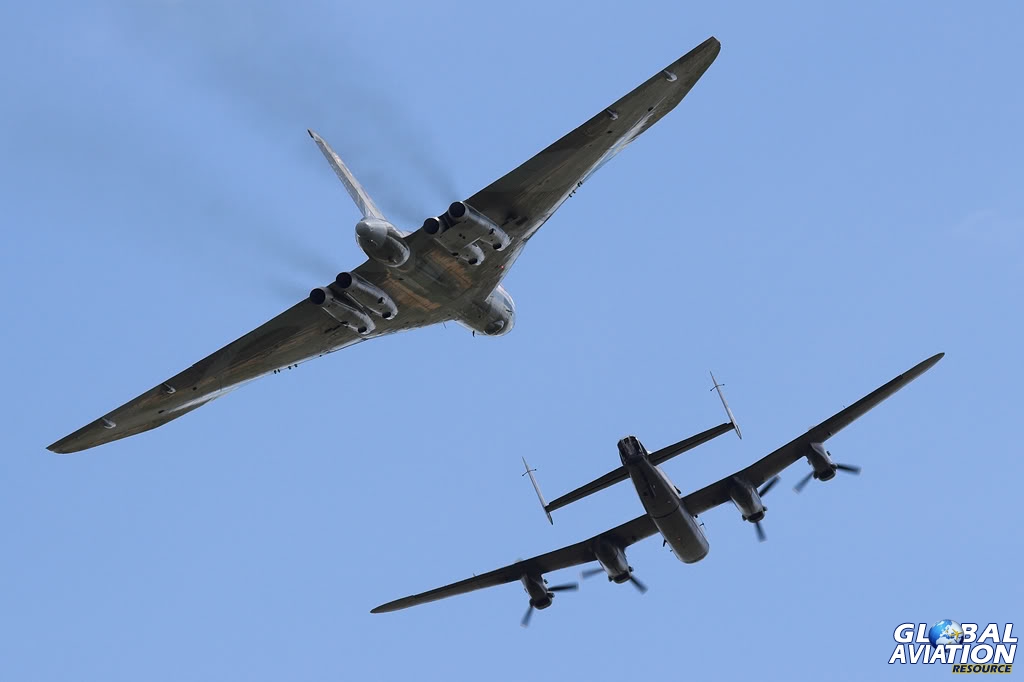
Vulcan XH558 and Lancaster PA474 at RAF Waddington in 2008 © Glenn Beasley www.globalaviationresource.com
With just eleven years between their first flights, but a huge technological gap in terms of design, construction, performance and capability, it still seems incredible that one man’s team of designers, namely that of Roy Chadwick, had such a big hand in the design of both the Lancaster and the Vulcan. Sadly, Chadwick died on 23 August 1947 in the crash of the Avro Tudor 2 prototype, and it was Stuart Davies, who had previously worked on converting the Manchester in to the Lancaster, who brought the Vulcan to life. Right now though it just seems incredible that we will get to see three of them flying together in 2014.
“I don’t think there is much doubt that this will be my favourite ever day in aviation, or certainly close to it. Opening the Farnborough Airshow in the Vulcan, with the Red Arrows, was memorable, especially bearing in mind my time with the Reds, but this is truly a once a lifetime opportunity. It’s going to be a very special day.” Bill tells me.

Just eleven years between the Vulcan’s and Lancaster’s first flights – incredible © Gareth Stringer www.globalaviationresource.com
That much is most certainly true and, with the Vulcan only slated to fly until the end of 2015, and with no prospect that the CWHM Lancaster will return to the UK any time soon, there is no doubt whatsoever that this will never happen again.
“In four years of displaying the Vulcan I have never hassled Kev Rumens, who rosters our flights, for any trip in particular, but when this one came up, I certainly did! I am very excited, but it is also a little daunting as well.”

Bill Ramsey © Gareth Stringer www.globalaviationresource.com
Bill’s first operational tour in the Royal Air Force was flying the Avro Vulcan, and it was that multi-engine experience, along with time spent on the Hastings and Jetstream as part of the CFS Exam Wing that, some years later, led to an invite from Dave Thomas, who displayed the Lancaster and the Vulcan for many years, to join the RAF BBMF.
“This was towards the end of 1998, and Dave invited me on-board, the plan being that I was going convert to the Lancaster and Dakota, get qualified for the left-hand seat and become an instructor and, at the end of the 1999 season, replace him as the RAF BBMF’s Bomber Leader.

PA474 in 2009 © Gareth Stringer www.globalaviationresource.com
“It was a lovely plan, but, in May 1999 we were displaying the Lancaster at the Southend Airshow when the supercharger on the No.3 engine failed, with plenty of smoke and flames, and we limped in to Southend Airport. That was the last time I flew the Lancaster, because there were no spare engines back in those days, and the only compatible Merlin powerplant they had was that in the Hurricane Mk.1, so a choice had to be made.
“In the meantime, out of the blue, I was offered a promotion by the RAF and a job in Saudi Arabia, so that was the end of the BBMF for me!”
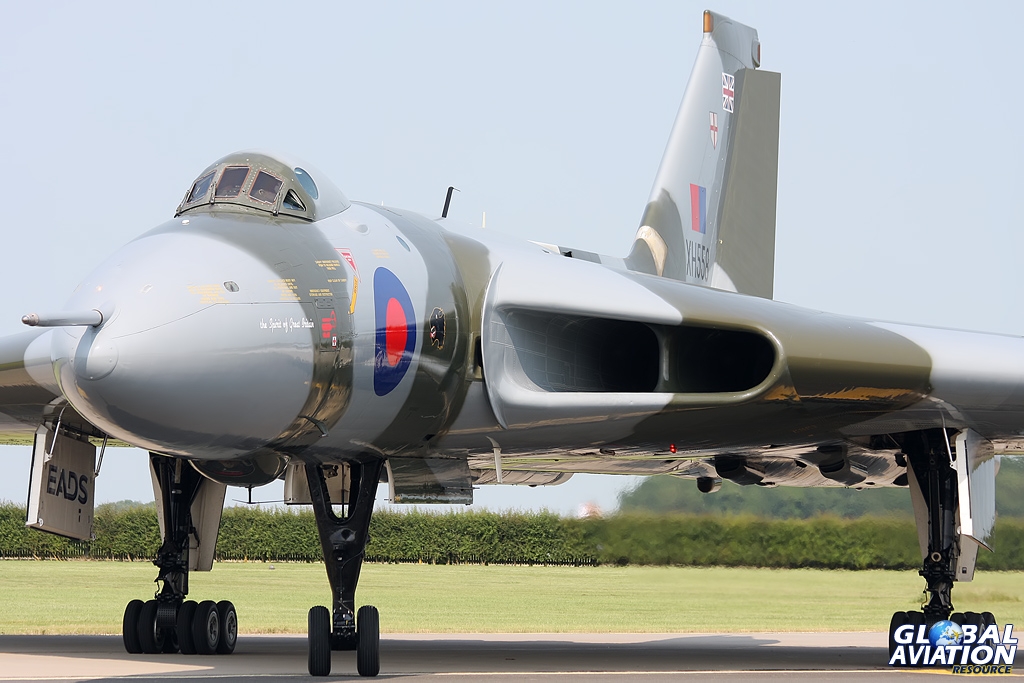
Vulcan XH558 at RAF Waddington in 2013 © Gareth Stringer www.globalaviationresource.com
He didn’t get to fly it for a long period of time, but what are Bill’s memories of flying the Lancaster, I wonder?
“A long time before all that, and to put it in to context, I had flown another four-engine tail-wheel aircraft, the Handley Page Hastings, so I do have something to compare the Lancaster with, as well as the Dakota of course. The Lancaster wasn’t my favourite aircraft to fly; I found it to be very heavy, especially the aileron controls, with a lot of adverse aileron yaw, and it was very difficult to land. It certainly wasn’t what I would call a pilot’s aircraft.
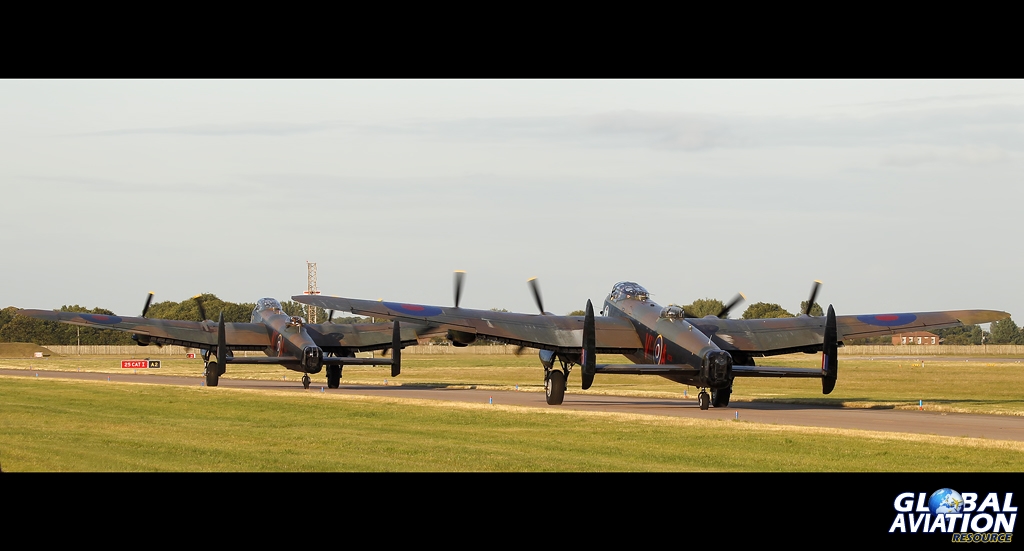
Taxying at RAF Coningsby last week © Steve Comber – www.globalaviationresource.com
“However, none of that detracts from the fact that when you climb over that huge main spar, struggle your way up to the cockpit and look out of that bubble window, you’re in a Lancaster, and there is nothing that compares with that. So, I don’t mean to give out mixed messages, but in the end, and despite what I think the aircraft’s handling shortcomings might be, it is still a Lancaster, and that makes it very, very special. The Vulcan is an infinitely nicer pilot’s aircraft, which played its own significant part in post-war history, but I don’t think any Vulcan pilot would challenge the Lancaster’s vital importance in world history! There is no doubt that the jump from Lancaster to Vulcan was a huge one, despite their relatively close proximity in terms of time, and in a performance sense, there is very little comparison. It is worth noting though that were more than a few nods to its lineage though, and the radar we carried in the Vulcan for example, H2S, was the same as that used by the Lancaster, albeit in an updated form.
“On the RAF BBMF we used to fly the Lanc at a maximum all-up-weight which was probably half of what they did in wartime, and we did so from pristine paved runways and during the day. Seventy years ago they were flying them at night, having had little training and with hardly any experience, at huge weights, off short grass runways and being shot at, with every prospect of not returning. I would sit there, in the ‘lightweight’ Lancaster and wonder, how did they do that?

The Lancaster stirs so many emotions and so many memories © Karl Drage – Global Aviation Resource
“The aircraft remains a focal point for the families of those who served on the Lancaster and in Bomber Command and we would often show veterans and their relatives around the aircraft. Sitting people in the crew positions they had sat in during the war, or showing their relatives, would frequently result in tears, and often you found yourself in tears too; it’s still a very emotional subject.”
Bearing his Lancaster experience and all that emotion in mind, what did Bill make of the journey completed by the CWHM simply to get Vera to the United Kingdom?

“What an epic adventure they’ve had” © Karl Drage – Global Aviation Resource
“I’ve crossed the Atlantic in a Hawk, using a very similar route and at a very similar time of year, albeit using one extra stop along the way, and I simply cannot emphasise enough what an epic adventure they’ve had. Even during August the weather could have turned very nasty, and it’s rather ironic that it got so bad when they reached Lincolnshire – but hats off to all those involved.”
The aforementioned differences in performance have made for some interesting planning ahead of the trip on Thursday, and on the day of this interview Bill had just returned from a lengthy meeting with Sqn Ldr Dunc Mason (OC RAF BBMF), Flt Lts Tim Dunlop and Roger Nichols (RAF BBMF Bomber pilots) and the CWHM crew, among others.

Bill and Kev Rumens displaying at RAF Cosford Airshow 2014 Gareth Stringer © www.globalaviationresource.com
“The first thing that is slightly unusual is that we have three aircraft all owned by different people and governed by different authorities with slightly different rules and regulations. That is why we won’t be taking this formation to a public display / airshow, as we would need to display in front of the RAF BBMF’s Air Officer Commanding in order to secure a PDA (Public Display Authorisation), and that would be time consuming and prohibitively expensive.
“In terms of the relative power of the aircraft, I will be leading the formation with the two Lancasters behind me, because we think that will be the most aesthetically pleasing way to do it. It also means that the most powerful aircraft is at the front, and you would normally have the aircraft with the most power at the back so they can do what they need to do to stay in formation.

The two Lancasters flying together at the Old Warden Flying Proms © Huw Hopkins – Global Aviation Resource
“That means I am going to have to consider those two aircraft, that I won’t be able to see, every single time I move the throttles, especially as whoever is on the outside of the turn needs most power to keep up. It’ll be fine; we just need to think about every move very carefully.”
The route itself, starting at RAF Waddington, will see the three aircraft departing and then flying a box pattern to the south-west / west of Lincoln to allow them to form up. They will then fly over the turf-cutting ceremony for the new Bomber Command Memorial and on to Metheringham, RAF Coningsby and then a straight line on to RAF Marham.
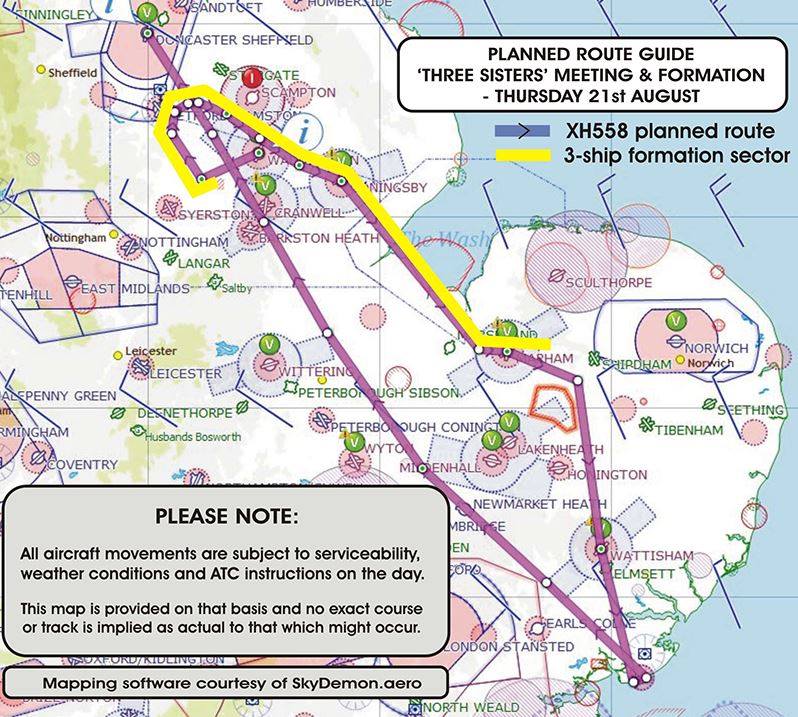
Planned route – c/o VTTS
From there the Vulcan will push on to Clacton for its display slot, and it will be followed by the Lancasters, which will have met up with the BBMF fighters by this time, for their own slot at the airshow.
The Vulcan will return home to Robin Hood while the Lancasters head to Southend to prepare for a weekend of airshows in the south of England.

The Lancasters were the star attraction at the Old Warden Flying Proms © Huw Hopkins – Global Aviation Resource
The whole thing will be photographed by John Dibbs from the back seat of a 100 Sqn Hawk T1 – and capturing the formation on camera, for posterity, is one of the most important elements of the trip.
The PAVE at RAF Waddington will be open to the general public (see this link for more information) and, bearing in mind the size of the formation and the distance it is covering, hopefully many people will get to see it, although there is no provision for a direct overflight of Waddington once the aircraft have departed.

There will actually be four Avro aircraft at Waddington on Thursday © Gareth Stringer www.globalaviationresource.com
“It is very exciting, but as I said earlier, it is quite daunting. I know everything that we need to do, though, and I honestly believe that as far as aviation events go, it doesn’t get too much bigger than this.”
I think we’d most likely agree with him.
Gareth Stringer would like to thank Bill Ramsey.



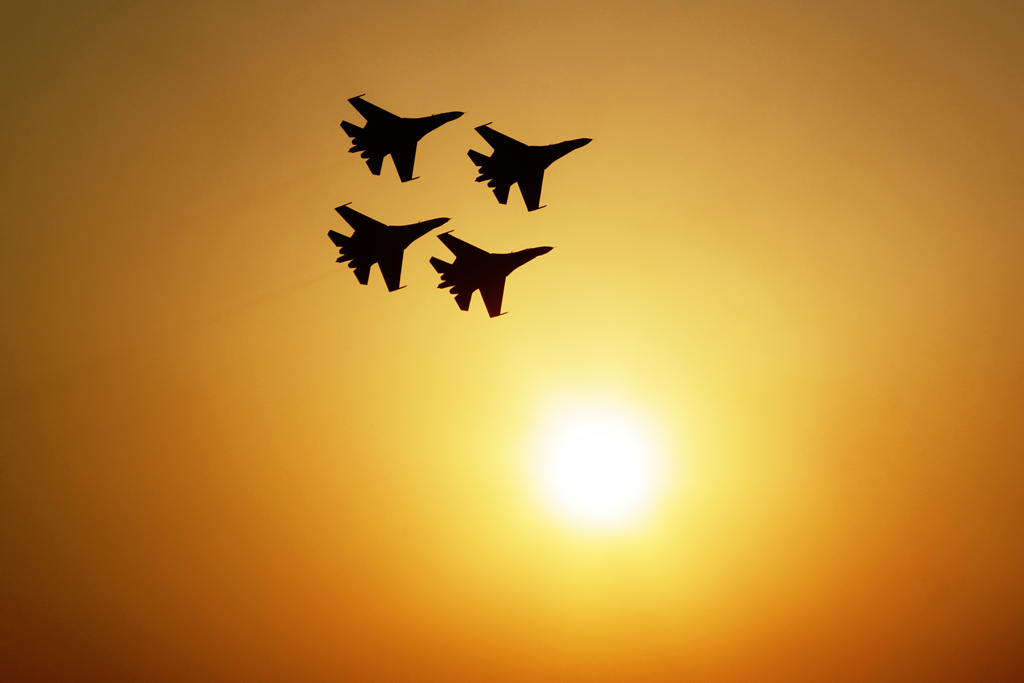



I live in Niagara Falls Ontario. We’re just a short jaunt from the Hamilton Warplane Museum ( http://www.warplane.com).
The Canadian Lancaster makes 1-2 flights almost every weekend right over our house and it’s is a familiar sound & sight (in the order) that’s never taken for granted. Watching as it flies directly over our house at low altitude is a delight and honour knowing that it is the only one left in regular service and can take guests onboard for a ride of a lifetime.
We are also frequented with US military planes of several description but nothing, nothing compares to the Lancaster. Enjoy her and send her home safely.
Cheers
Bob
Hi Bob,
I recently received my October copy of Flypast and started to read the article “The Crossing” covering the journey of “your” Lancaster to the UK. I have to admit to you that so far I been unable to finish reading it due to the emotion I was feeling. The total commitment of ALL the people involved in that exercise totally cracked me up. I quite envy you your locality.
Regards,
Les
I was in the RAF from 1978 untill 1990. I trained as an armourer and worked at RAF Waddington in 78 & 79. My job was the renovation and maintenance of the Vulcuns weapon ground support equipment including the SABT and power pack. We were once tasked with renovating and spraying a bomb trolley in war time colours for the Battle of Britain Flight Lancaster with a promise of a flight for our efforts.
We never got the flight but we were all proud to do our bit for the BoBF. Some of my fondest memories are of working with the Vulcun in all of its roles during that time and I will never forget having to stand on tiptoe on the top of folding steps fitting HASU units into the bomb bay with a howling wind blowing across the pan.
Thank you to all concerned for bringing these three aircraft together possibly for the last time ever and reminding us all how beautiful these aircraft are to eyes and ears and may they forever stay in our memories.
Wow! I wish I could have been there to see it! My grandfather was a Lancaster pilot in 44 and 49 Squadron and Lancasters have a special place in our hearts. (Flt. Sgt Tom Webster DFM
Rhodesian Pilot)
Thank you so much we saw you fly over conigsbury it was amazing,above the noise of you all I could hear my 2 grandsons going wow wow awesome best thing we’ve ever seen,so a big thank you from the millward family.x
Watched the flight from the sea bank near Gedney Drove End. Absolutely awesome to see them from tiny specks in the distance to passing behind us and carrying on. Awesome, awesome, awesome.
PS. I am not normally a fan of ‘social media’ but standing on a cold windy bank in the midlle of nowhere surrounded by cows, I was really grateful for the pilots twitter feed.
Dear Mandy, thank you for the kind comments. Just want to wrap up a fantastic day from my point of view to thank everyone who chose to take part in the occasion by getting out of bed and coming to have a look. I’ve made some great new friends in the brilliant Canadian crew and renewed some old friendships – in the end what it’s all about. Best of all met a fantastic Australian gent also called Bill, aged 91, 37, I think, Lanc Ops and still sharper than me by a mile.
As my friends at the BBMF say. ” Lest We Forget”
Bill
Not sure I’ll get up to Waddington in time, what time do you think they’ll arrive at RAF coningsby? Would hate to miss this fly by
Would hope that the aircraft would be seen from Doddington and the area surrounding. We can’t all have cars to drive up to Waddington. The whole population of Lincoln would be so happy as it’s probably the last time they will ever be seen in the uk.
We missed the fly pass at Ramsey 1940’s show doe to bad weather. Would love to know what time they are flying over the Peterborough area tomorrow. Would be great to catch a glimpse of the majestic lancasters.
Do you know if they will cross east or west of Sutton Bridge, i.e. across The Wash or inland of The Wash. Thanks
Route now added, Geoff.
Thank you Gareth, much appreciated.
Does anyone know the approx flight time for the Vulcan back from Clacton to Robin Hood, especially as it passes near Peterborough?
I hope that Dibbsy’s photos will come out publicly, sadly i’m working tomorrow, otherwise theres a good chance me and a few others would have been somewhere near CBY. I dont think this ‘do’ at Waddo has been thought out, planned and arranged at all well considering the cost and viewing restrictions imposed, but I would really love to see some nice shots, and at some time Bill, let the Lancs take the lead – a nice echelon shot from the hawk looking back across the flight.
Enjoy all the same, it really is a once in a lifetime event and i’m sad i will miss it.
Phil, as I think Bill would confirm, even getting to this stage, and ensuring that people can see the aircraft at Waddington, has taken a vast amount of thought and planning.
Dear Phil, sorry you feel the Waddington aspect has not been thought out or planned well. I promise you I have worked non- stop for the last two weeks to get to where we are, as have many other people. However, thanks for this opportunity to clarify one or two things which didn’t come up in the interview or have been incorrectly reported elsewhere.
The Waddington Flypast. Whilst I fully understand the desire to do a flypast at Waddington (honestly, so would I) I’ve tried to explain some of the practical and regulatory issues surrounding this unique formation. The RAF authorities will only allow this formation to fly together in as straight a line as possible – that means I cannot turn off the Memorial Flypast to do Waddington. In other areas the regulations applying to Vulcan are more restrictive. Therefore a lot of compromise has gone into the final plan which we feel will please most but inevitably not everyone. Practically, this is not a good idea either as, the formation has never flown together before, the pilots have not practiced together, and whilst we know the performance of the aircraft is hugely different, we won’t know by how much exactly until we fly tomorrow. Ultimately, Safety underpins everything.
From what I’ve said already, even if was practicable, you’ll understand there is no chance of the Lancs taking the lead. PS as I know from flying Hawk Photochase, an over the shoulder picture at something behind you would challenge even Mr Dibbs.
I have every sympathy with those who cannot get everything they would personally like from this event, but let’s all just enjoy the fact that this once in a lifetime event is happening at all and many, many folks will get the chance to see it or catch up with it through the media.
Bill Ramsey
Dear Bill, My father was a Pathfinder and completed 46 operations with his crew intact – he would have loved to see them escorted by you in the wonderful Vulcan. Somewhere I will try and be on the ground eyes peeled. x
Bill, Please perform the flypast with the Lancs over Waddington runway. Why have all 3 aircraft at Waddington taking off then formating east of the airfield to do a flypast over Canwick Hill which is 4.4 miles away from Waddington and NOT flying over Waddington itself? Can you not fly due south from Canwick Hill and take in the airfield on the way? I can imagine the PAVE will be packed on Thursday and with people paying a tenner and buying shares etc will be mega p***ed off to miss out when its passing by in the distance.
Cheers Lee,
will the flight path come over Oxford?
A straight line from Coningsby in Lincs to Marham in Norfolk, Peter, so no, not Oxford I’m afraid.
I tried to see the Lancasters over the weekend, but the weather beat us, any idea what time you are due to be at RAF Marham?
Oh hoping to catch sight of these on Thursday going over Coningsby, this will be my third attempt to see them in the air. Brought my two grandsons to meet and welcome Vera when she arrived here,they made their own flags and were thrilled when pilot came over to say hello,had amazing day although got very wet,a day I hope the boys will remember,I certainly will. Take extra care, so love you all x
Bill
What time will these fly from waddington if I wanted to come up and watch them fly over?
Thanks!
Sadly I won’t be able to be at Waddington to see this. My father Roly Falk test flew the Vulcan and my grandfather Bill Thorn test flew the Lancaster. Will watch the recordings of the day and the photos with great interest!
Hi John, that’s quite a pedigree! Sorry you can’t make it. We’ll do our best to live up to your father and grandfather’s standards.
Bill Ramsey
Thanks Bill, I’m sure you and the whole team will!
Hi Bill,
Just want to say that as a supporter of XH558 I am so proud that this event is happening,this for me is the high point since 558 took to the skies after the restoration,also to have the Canadian Lancaster in the UK is an honour,the crew did a fantastic job getting her here,thanks to all who have worked so hard to bring this together,hope the weather is kind,hope you all have a great day,
Regards.
Steve
Will the flight path on Thursday pass over Kings Lynn?
Probably relatively close, Brian, but most likely not directly.
Thanks for that Gareth, much appreciated. I’m hoping to get near Marham, but failing that I’ll watch the skies near Kings Lynn.
Any chance of finding out what time, Vulcan and lancasters leaving Waddington. Would love to see them! 🙂
Hi Lynne, all the information is on this web site.
Sorry lynne it didn’t show the web site I put in, here is a link- http://www.raf.mod.uk/rafwaddington/newsweather/index.cfm?storyid=11B3DBF1-5056-A318-A802C5A20D39A135